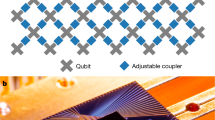Abstract
Reversible computers which carry out each step without discarding information can, in principle, dissipate arbitrarily small amounts of energy per step if the computation is carried out sufficiently slowly. This has caused a re-examination of energy requirements in communication and measurement. There also, it is only those steps that discard information which have a lower limit on energy consumption. Such steps can be avoided in the transmission of information.
This is a preview of subscription content, access via your institution
Access options
Subscribe to this journal
Receive 51 print issues and online access
$199.00 per year
only $3.90 per issue
Buy this article
- Purchase on Springer Link
- Instant access to full article PDF
Prices may be subject to local taxes which are calculated during checkout
Similar content being viewed by others
References
Keyes, R. W. IBM J. Res. Dev. 32, 24–28 (1988).
Shannon, C. E. Bell Syst. tech. J. 27, 379–423, 623–656 (1948).
Brillouin, L. Science and Information Theory 267–286 (Academic Press, New York, 1956).
Maxwell, J. C. Theory of Heat 1st edn (Longmans Green, London, 1871).
Landauer, R. IBM J. Res. Dev. 5, 183–191 (1961).
Bennett, C. H. IBM J. Res. Dev. 17, 525–532 (1973).
Bennett, C. H. Int. J. theor. Phys. 21, 905–940 (1982).
Landauer, R. in Der Informationsbegriff in Technik und Wissenschaft (eds Folberth, O. G. & Hackl, C.) 139–158 (Oldenbourg, Munich, 1986).
Wright, R. The Atlantic 261, 29–44 (April, 1988).
Fredkin, E. & Toffoli, T. Int. J. theor. Phys. 21, 219–253 (1982).
Landauer, R. Ber Bunsenges 80, 1048–1059 (1976).
Landauer, R. Int. J. theor. Phys. 21, 283–297 (1982).
von Neumann, J. Non-linear Capacitance or Inductance Switching, Amplifying and Memory Organs (US Patent 2,815,488).
Goto, E. J. electl Commun. Engrs Japan 38, 770–775 (1955).
Likharev, K. K. Int. J. theor. Phys. 21, 311–326 (1982).
Likharev, K. K., Rylov, S. V. & Semenov, V. K. IEEE Trans. Magn. 21, 947–950 (1985).
Landauer, R. & Büttiker, M. Phys. Scripta T9, 155–164 (1985).
Bennett, C. H. IBM J. Res. Dev. 32, 16–23 (1988).
Bennett, C. H. Sci. Am. 255, 107–116 (1987).
Kuhn, H. IBM J. Res. Dev. 32, 37–46 (1988).
Kondepudi, D. K., Moss, F. & McClintock, P. V. E. Physica D 21, 296–306 (1986).
Zurek, W. H. in Frontiers of Nonequilibrium Statistical Physics (eds Moore, G. T. & Scully, M. O.) 151–161 (Plenum, New York, 1986).
Lubkin, E. Int. J. theor. Phys. 26, 523–535 (1987).
Landauer, R. in Signal Processing (ed. Haykin, S.) (Prentice-Hall, New Jersey, in the press).
Greenberger, D. M. (ed. New Techniques and Ideas in Quantum Measurement Theory (Ann. New York Acad. Sci., 1986).
Roth, M. & lnomata, A. (eds) Fundamental Questions in Quantum Mechanics (Gordon & Breach, New York, 1986).
Bennett, C. H. & Landauer, R. Sci. Am. 253(7), 48–56 (1985).
Szilard, L. Z. Phys. 53, 840–856 (1929).
Gabor, D. in Progress in Optics Vol. 1 (ed. Wolf, E.) 109–153 (North-Holland, Amsterdam, 1961).
Daub, E. E. Hist. Phil. Sci. 1, 213–227 (1970).
Landauer, R. Found. Phys. 16, 551–564 (1986).
Deutsch, D. Proc. R. Soc. Lond. A 400, 97–117 (1985).
Streda, P., Kucera, J. & MacDonald, A. H. Phys. Rev. Lett. 59, 1973–1975 (1987).
Pendry, J. B. J. Phys. A 16, 2161–2171 (1983).
Bekenstein, J. D. Phys. Rev. A 37, 3437–3449 (1988).
Landauer, R. Appl. Phys. Lett. 51, 2056–2058 (1987).
Sturge, M. D. in No Way (eds Davis, P. J. & Park, D.) 111–138 (Freeman, New York, 1987).
Landauer, R. Speculations in Science and Technology 10, 292–302 (1987).
Landauer, R. Phys. Scripta 35, 88–95 (1987).
Author information
Authors and Affiliations
Rights and permissions
About this article
Cite this article
Landauer, R. Dissipation and noise immunity in computation and communication. Nature 335, 779–784 (1988). https://doi.org/10.1038/335779a0
Issue Date:
DOI: https://doi.org/10.1038/335779a0
This article is cited by
-
Additively manufacturable micro-mechanical logic gates
Nature Communications (2019)
-
Multiscale Entropy and Its Implications to Critical Phenomena, Emergent Behaviors, and Information
Journal of Phase Equilibria and Diffusion (2019)
-
Spatial scales of living cells and their energetic and informational capacity
European Biophysics Journal (2018)
-
Cosmic Background Bose Condensation (CBBC)
Astrophysics and Space Science (2013)
Comments
By submitting a comment you agree to abide by our Terms and Community Guidelines. If you find something abusive or that does not comply with our terms or guidelines please flag it as inappropriate.



